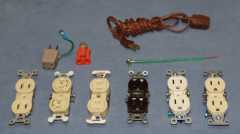I've spent the past few days replacing outlets in Mom's 62 year old home. Here's a rogue's gallery

That "cheater" in the upper left has no polarization on it's blades, but polarization on its outlet end. The green wire is intended to attach to the screw in the middle of old outlets. There are a couple of ways this can go wrong!
The orange cheater is better, but, only grounds properly if the screw is grounded, meaning the outlet is attached to a metal box and it is grounded. In most homes where this would work, there would be a conduit from the metal box to the grounded circuit breaker box. In this house, for some reason, there is no conduit, but the cable itself has the bare ground wire, just like modern Romex, and the electrician tied it to the metal boxes. Made my job much easier!

The extension cord was in our basement. I needed an extension cord to run a light from another room so I could see with the power out. Not this cord though! Neither side is polarized, and so won't accept a polarized plug. I thought polarized plugs were standard since the 20's suggesting this extension cord is somewhat older. Wonder if there is a museum for such things? Is it a collectible? Could I sell it on e-bay? (Not for actual use, display purposes only.) Knowing my Dad, if he'd found this, he would have simply cut off the offending outlet side and wired in a newer one. Never mind the plug still wouldn't be polarized...

Watching several videos, including one from This Old House (Norm would never lie to us!) the acceptable fix for adding grounded outlets in a house where the metal boxes are grounded is to buy a bunch of these green wire pig-tails, screw the #10 screw into the threaded hole in the back of the box, and attach it to the ground terminal in the outlet. Super!

That's what I did. Does make me wonder though, since evidently simply letting the grounded box bond to the metal bits of the outlet through the regular two screws that hold it in isn't safe enough, how did those cheaters get their UL rating? Also, why did the metal box manufacturers back in the 1950's thoughtfully add those threaded holes (2 each in our case!) to the backs of their boxes?
The outlet front row left is one of the originals. The next one over was one of the safety outlets Dad added to my bedroom and the dining room. They don't look polarized, but they are. They are branded Bell (presumably not the phone company). Several years later, Dad put them in my brother's room and those are branded Sears Robuck, except they look the same in every other way. Sears must have added their name when they sold them.
A few years after that, my sister came along, and Dad added safety outlets to her room; this time GE's version.
When I was a teenager, I wanted a grounded outlet in my room for my shortwave radio hobby. I didn't much care if the colors matched, and I found the brown one somewhere. Taking after my Dad, I managed to tie the line to neutral and neutral to line. No one died from that mistake, and it has been corrected.
The two on the right are two different brands of the modern TR outlets I'm using as replacements throughout the house. Where we still have original ivory wall plates, I replaced with like color. Most plates are painted the room color and the light tan seems (to me) to look better. It is interesting to me though that all of the outlets except the Eaton's (on the right) have a contoured surface. Not sure how that helps.
So, with all this variety, I wonder if there is an electrical outlet museum somewhere?*

I once rented a 1940's house and did a similar replacement, and I think I still have some of the ceramic outlets from that one.
Oh, and I should have probably said this sooner, if you aren't interested in the subtleties of North American electrical outlets through the last 62 years, you may find this post somewhat boring, and may wish to skip it entirely. Sorry about that!

Tom
*Edit: If you are interested in the subtleties, check this out:
https://www.plugsocketmuseum.nl/NorthAm2.html












 That's what I did. Does make me wonder though, since evidently simply letting the grounded box bond to the metal bits of the outlet through the regular two screws that hold it in isn't safe enough, how did those cheaters get their UL rating? Also, why did the metal box manufacturers back in the 1950's thoughtfully add those threaded holes (2 each in our case!) to the backs of their boxes?
That's what I did. Does make me wonder though, since evidently simply letting the grounded box bond to the metal bits of the outlet through the regular two screws that hold it in isn't safe enough, how did those cheaters get their UL rating? Also, why did the metal box manufacturers back in the 1950's thoughtfully add those threaded holes (2 each in our case!) to the backs of their boxes? I once rented a 1940's house and did a similar replacement, and I think I still have some of the ceramic outlets from that one.
I once rented a 1940's house and did a similar replacement, and I think I still have some of the ceramic outlets from that one.
















